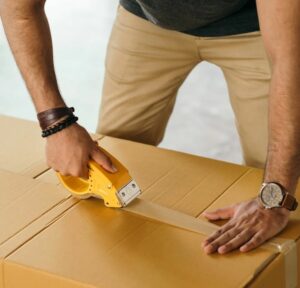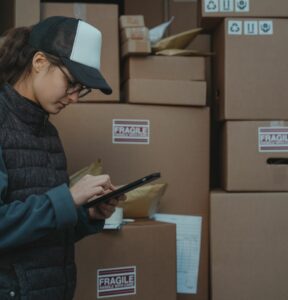Login

Content:
- Why should you comply with the Amazon FBA shipping requirements
- Amazon FBA shipping requirements
- Amazon FBA packaging guidelines
- Amazon FBA product labels
Amazon FBA, or Fulfillment by Amazon, is a service offered by Amazon to e-commerce business owners. It’s a popular program that allows you to leverage Amazon’s vast fulfillment network to store, pack, and ship your products to customers.
Amazon FBA can be a valuable resource for e-commerce business owners as it simplifies many aspects of order fulfillment and logistics. It allows you to focus on growing your business while Amazon handles the operational aspects. However, it’s essential to understand the associated costs and requirements before enrolling in the program and to optimize your product listings for success on the Amazon platform.
The Amazon website has a comprehensive help service within Seller Central that can provide you with advice on packaging and prep requirements.

Why should you comply with the Amazon FBA shipping requirements
Complying with Amazon FBA shipping requirements is crucial for several important reasons that directly impact your business’s success and reputation on the platform:
Smooth Processing: Amazon’s fulfillment centers receive and process a vast number of packages daily. By adhering to their shipping requirements, you help ensure that your shipments can be quickly and accurately processed. This means your products are made available for sale faster, leading to quicker fulfillment for your customers.
Customer Satisfaction: When your products are fulfilled by Amazon, customers often expect fast and reliable service. Properly labeled and packaged shipments contribute to a positive customer experience by reducing the risk of delays, order mix-ups, or damaged products.
Reduced Fees: Non-compliance with Amazon’s FBA shipping requirements can lead to additional fees and charges. This can impact your profitability, particularly if your shipments require rework or relabeling by Amazon associates. By following the guidelines, you can avoid these extra costs.
Time and Cost Savings: Following the rules from the start can save you time and money in the long run. Avoiding issues related to non-compliance, such as rework or returns, allows you to focus on growing your business and maximizing your profits.
In summary, complying with Amazon FBA shipping requirements is not just about following rules; it’s about ensuring the smooth operation of your business on the platform, providing an excellent customer experience, and protecting your account’s health and reputation.
By doing so, you increase your chances of success as an Amazon seller.
So, why does Amazon can refuse your shipments?
Shipments refused by Amazon are a devastating disaster for sellers. However, this will rarely happen if you strictly adhere to Amazon’s packaging and shipping requirements.
Among the most common Amazon rejection reasons are:
- The shipment doesn’t have a shipment label
- The pallet is overhanging, overhigh, or overweight
- The shipment was canceled or deleted
- The shipping plan has expired (over 90 days)
- The shipment is delivered from overseas to an Amazon center, but the duties or taxes have not been paid

Amazon FBA shipping requirements
Amazon FBA has specific shipping requirements that sellers must adhere to in order to use the service effectively. These requirements help ensure the smooth handling of your inventory within Amazon’s fulfillment centers.
Here are the key shipping requirements for Amazon FBA:
- Shipping Labels: You need to use Amazon’s labeling system or barcodes (FNSKU or UPC/EAN) on each unit of your product. Amazon provides labels for your products, which should be attached as directed. This is crucial for accurate tracking and inventory management.
- Packaging Guidelines: Amazon has strict packaging guidelines to protect your products during shipping and storage. Items must be packaged securely to prevent damage. This includes using appropriate boxes, bubble wrap, or packaging materials to cushion and protect your products.
- Shipping Carrier Selection: You can choose your shipping carrier to send your inventory to Amazon’s fulfillment centers. Amazon provides carrier options, but you can also use third-party carriers if you prefer.
- Shipping to Multiple Fulfillment Centers: Depending on the size and quantity of your inventory, Amazon may require you to send your products to multiple fulfillment centers. Amazon’s shipment creation process will guide you on how to split your shipments accordingly.
- Shipment Labels: Each box you send to Amazon’s fulfillment center must have a unique shipment label generated through Amazon’s platform. These labels help Amazon track and sort your inventory upon arrival.
- Box Weight and Dimensions: You should accurately measure and weigh your boxes before shipping them to Amazon. Incorrect measurements can result in additional fees.
- Shipping Schedules: You need to schedule shipments to Amazon’s fulfillment centers in advance. Amazon provides tools to help you create shipment plans and choose delivery windows.
- Carrier Tracking: You should provide carrier tracking information for your shipments so that Amazon can monitor the progress of your inventory as it’s in transit.
- Storage Limits: Amazon may impose storage limits on your inventory, especially if you are a new seller or have low sales volume. Be mindful of these limits to avoid overstocking.
- Long-Term Storage Fees: Amazon assesses long-term storage fees for products that have been stored in their fulfillment centers for an extended period. Regularly review and manage your inventory to avoid these fees.
It’s important to regularly check Amazon’s official guidelines and policies for any updates or changes to their shipping requirements, as they may evolve over time. Adhering to these requirements will help ensure that your products are handled efficiently and that you maintain a good relationship with Amazon as an FBA seller.
Amazon FBA Packaging Guidelines
Amazon’s Packaging Guidelines are a set of rules and recommendations that sellers using Amazon FBA (Fulfillment by Amazon) must follow when preparing their products for shipment to Amazon’s fulfillment centers.
Here are some key aspects of Amazon’s Packaging Guidelines:
- Product Protection:
The primary goal of packaging is to protect your products from damage during transit and storage. Use appropriate packaging materials, such as boxes, bubble wrap, or polybags, to safeguard your items.
- Box Strength:
Select sturdy, corrugated boxes that can withstand the weight of your products without collapsing. Overloaded or flimsy boxes can lead to damage and complications during shipping and handling. For outer cartons we recommend extra hard 5 layer boxes.
- Box Size
Choose box sizes that are appropriate for your products. Avoid using oversized boxes that leave too much empty space, as this can increase shipping costs and the risk of damage. On the other hand, don’t use boxes that are too small, as they may not adequately protect your items.
- Multi-Item Packaging
If you are sending multiple units of a product in one box, make sure they are properly secured and won’t shift during transit. Use dividers, partitions, or packaging materials to prevent items from coming into contact with each other.
- Fragile Items
Clearly label boxes containing fragile items. You can use “Fragile” stickers or markings to alert Amazon associates and carriers to handle these boxes with care.
- Polybags
If you use polybags to package items, they must meet Amazon’s polybag requirements. These include being transparent, sealed properly, and including a suffocation warning label if applicable.
- Expiration Dates
If your products have expiration dates, ensure that they are clearly marked and easy to read. Amazon may remove products with unclear or expired dates.
- Proper Sealing
Seal your boxes securely with appropriate packaging tape. Ensure that all seams and flaps are sealed to prevent the box from opening during transit.
- Labeling
Avoid covering important product information or barcodes with labels or packaging tape. Labels should be applied neatly and legibly.
- Remove Previous Labels
If you are reusing boxes, make sure to remove any previous shipping labels or markings to prevent confusion during receiving.
- Overboxing
Avoid placing a box within another box (overboxing) unless it is necessary for extra protection or if Amazon specifically requests it. Overboxing can lead to extra fees.
- Amazon Barcode Placement
If you are using Amazon’s barcode labeling service, make sure the barcode labels are applied to the correct locations as indicated in your shipment plan.
Amazon FBA shipping requirements – Product Packaging
Polybag Products
The requirements for polybags:
- Thickness: The poly bag must be at least 1.5 mils (0.0015 inches or 0.0381 mm). By the way, most polybags are between 1-6 mils thick
- Color: Most Amazon FBA products are packaged in transparent polybags, except adult products which must be packaged in black or opaque polybags
- Required label: A suffocation warning must be printed or labeled in a prominent place on the polybag if the polybag is 5 inches (12.5 cm) or larger
- Quality: Polybags must be of good quality and stay in good condition during transportation
Box Products
The requirements for boxes
- Type: Square or rectangular boxes
- Quality: Product boxes must be high quality and remain in good condition during transportation
Fragile Products
The requirements for fragile products
- Packaging materials: Use bubble wrap or a square or rectangular box
- Test: Fragile products should pass the three-foot drop test (including five drops: the bottom, the top, the longest side, the shortest side, and the corner of the box).

Amazon FBA shipping requirements – Product Labels
Here’s the key information you should include on your Amazon FBA shipping labels:
Carrier and Tracking Information:
The name of the carrier or delivery service you’re using to ship your products to Amazon.
The carrier’s tracking number for the shipment.
Product Information:
A description of the products contained in the shipment.
The number of units or items in the shipment.
Information regarding whether the products are new or used (if applicable).
Barcode Information:
The barcode or label specific to the shipment or box, which is generated through Amazon’s FBA shipment creation process.
Shipping Labels Position:
Ensure that the shipping label is affixed to a visible and easily scannable location on the package. Amazon provides guidelines on where to place labels for optimal scanning.
Additional Handling Information:
If your products are fragile or require special handling, you may include “Fragile” or other relevant handling instructions on the label.
Return Address:
Your return address, in case the package cannot be delivered to the fulfillment center and needs to be returned to you.
Shipment Contents:
It’s important to generate and print these shipping labels through Amazon’s Seller Central platform when creating your shipment plan. Amazon will provide you with the necessary labels, including FBA barcodes and shipment ID labels, as part of the shipping workflow. Follow Amazon’s guidelines on label placement to ensure that your shipments are processed efficiently.
Properly labeled packages reduce the risk of errors during receiving, help Amazon associates quickly identify your inventory, and ensure that your products are available for sale as soon as possible. Failure to follow Amazon’s labeling requirements can result in delays, additional fees, or even the rejection of your inventory.

If you have any questions about Amazon FBA shipping requirements, contact our team and we can help to guide you through the process.
